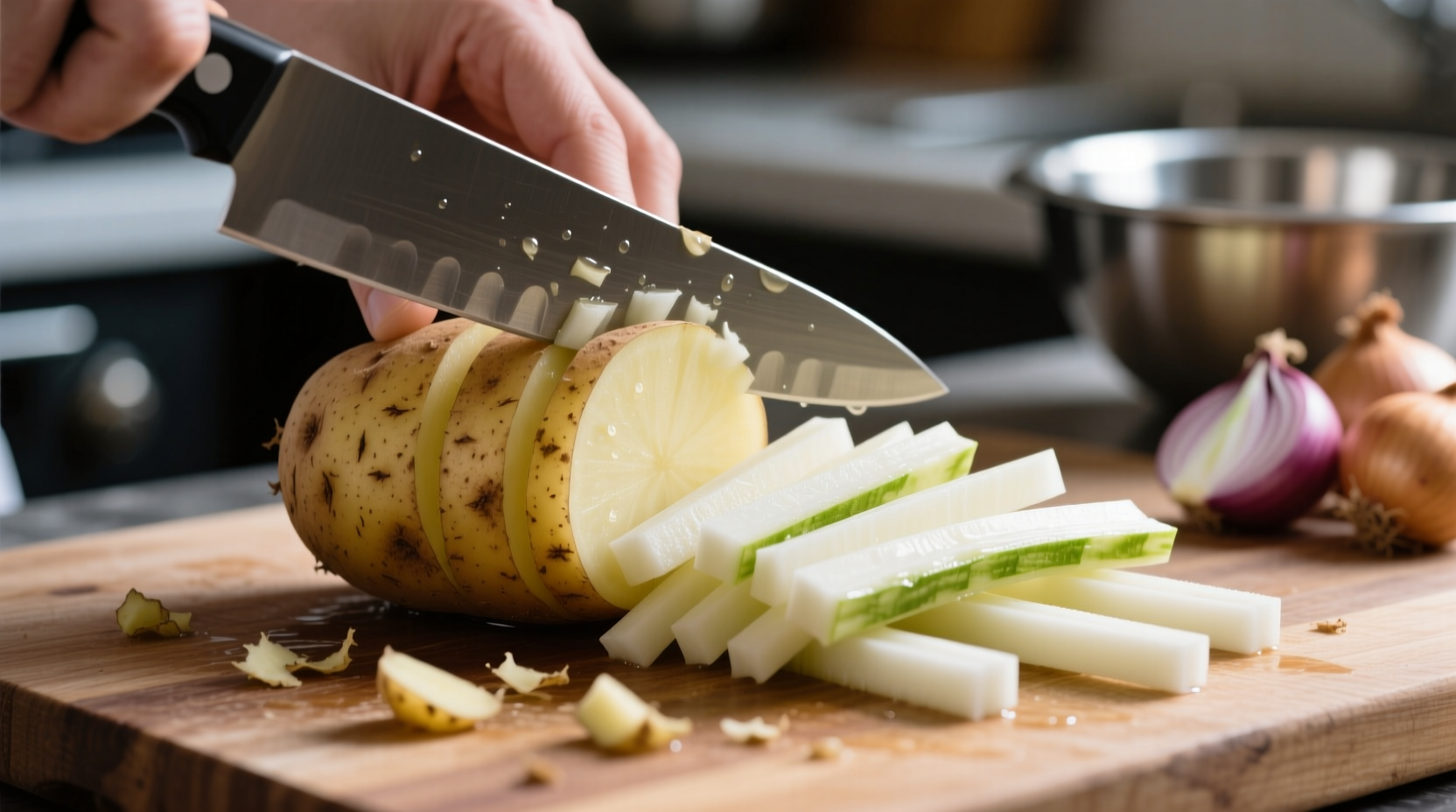Mastering the julienne cut transforms ordinary potatoes into restaurant-quality ingredients. Whether you're preparing crispy hash browns or elegant vegetable garnishes, this fundamental knife skill separates amateur cooks from professionals. Let's break down exactly how to julienne potatoes with precision and confidence.
What Exactly Is a Julienne Cut for Potatoes?
The julienne cut creates uniform, slender strips that cook evenly and present beautifully. For potatoes specifically, this means:
- Dimensions: 1/8 inch × 1/8 inch × 2 inches (3mm × 3mm × 5cm)
- Texture: Firm enough to hold shape during cooking
- Appearance: Consistent matchstick-like strips
Unlike rough chopping, the julienne technique requires methodical precision. According to the Culinary Institute of America, this cut originated in French cuisine where uniformity affects both cooking time and visual presentation.
Why Julienne Potatoes Instead of Other Cuts?
Different potato cuts serve different culinary purposes. The julienne cut offers specific advantages:
| Cut Type | Dimensions | Best For | Potato Cooking Time |
|---|---|---|---|
| Julienne | 1/8" × 1/8" × 2" | Stir-fries, hash browns, garnishes | 5-7 minutes |
| Batonnet | 1/4" × 1/4" × 2" | French fries, roasting | 12-15 minutes |
| Medium Dice | 1/2" cubes | Stews, soups | 20-25 minutes |
This comparison shows why julienne works best when you need quick-cooking, crispy potato elements. The smaller surface area-to-volume ratio creates that perfect golden-brown exterior while maintaining tender interior texture.
Essential Tools for Perfect Potato Julienne
You don't need expensive equipment, but the right tools make all the difference:
- 8-10 inch chef's knife: Must be sharp - dull knives crush rather than cut potatoes
- Cutting board: Stable, non-slip surface (wood or plastic)
- Bowl of cold water: Prevents oxidation and removes excess starch
- Optional but helpful: Mandoline slicer with julienne blade (use guard!)
Professional chefs at King Arthur Baking Company emphasize that knife sharpness matters more than knife cost. A properly sharpened $20 knife outperforms a dull $200 knife every time.
Step-by-Step: How to Julienne a Potato Like a Pro
Preparation Phase
- Choose the right potato: Russet or Yukon Gold work best (waxy potatoes like reds don't julienne well)
- Wash and peel (optional): Most chefs leave skin on for nutrients, but peel if desired
- Cut ends off: Create flat surfaces for stability
- Soak in cold water for 10 minutes: Removes surface starch for cleaner cuts
Cutting Technique
- Slice into planks: Cut potato lengthwise into 1/8-inch thick slices
- Stack slices: Group 3-4 slices together for efficiency
- Cut into matchsticks: Slice stacked planks lengthwise into 1/8-inch strips
- Rotate and repeat: Turn strips 90 degrees and cut again for perfect uniformity

Avoid These 3 Common Julienne Mistakes
Even experienced home cooks make these errors when learning to julienne potatoes:
- Inconsistent thickness: Varying widths cause uneven cooking. Solution: Use guide sticks (1/8-inch dowels) alongside your potato
- Skipping the soak: Excess starch makes cuts sticky and uneven. Always rinse after cutting
- Using a serrated knife: Creates ragged edges that break during cooking. Only use sharp chef's knives
According to a University of Illinois Extension study on vegetable preparation techniques, properly julienning potatoes reduces cooking oil absorption by 22% compared to irregular cuts, creating healthier finished dishes.
Culinary Applications for Julienne Potatoes
Now that you've mastered the cut, here's how to use your perfectly julienning potatoes:
- Hash browns: Par-cook then pan-fry for crispy edges
- Stir-fries: Add in last 2 minutes to maintain texture
- Garnishes: Deep-fry for elegant potato straws
- Vegetable medleys: Combine with julienning carrots and bell peppers
Professional chefs recommend cooking julienne potatoes immediately after cutting for best results. If storing, keep submerged in cold water with lemon juice to prevent browning.
Julienne vs. Other Cuts: When to Choose What
Understanding cut differences prevents recipe failures:
- Julienne vs. Batonnet: Batonnet is twice as thick (1/4" vs 1/8") - use for french fries
- Julienne vs. Brunoise: Brunoise is diced julienne (1/8" cubes) - for fine garnishes
- Julienne vs. Shreds: Shreds are irregular and thinner - better for latkes than precise dishes
Remember: The julienne cut's specific dimensions create the ideal surface area for quick, even cooking while maintaining structural integrity - crucial for dishes where presentation matters.
Perfecting Your Potato Julienne Technique
Like any knife skill, practice makes perfect. Start with these progression steps:
- Practice on firm vegetables like carrots first
- Use guide sticks until comfortable with freehand cutting
- Time yourself - aim for 3 minutes per potato
- Compare your cuts to professional examples
Within 10 potatoes, you'll notice significant improvement. The key is maintaining consistent pressure and using the full length of your knife blade with each stroke.











 浙公网安备
33010002000092号
浙公网安备
33010002000092号 浙B2-20120091-4
浙B2-20120091-4